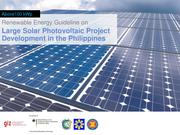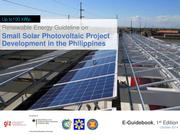Difference between revisions of "Solar Photovoltaic Project Development in the Philippines"
***** (***** | *****) (Created page with "= Overview = The Philippines is located just right above the equator. It is blessed with a good potential for solar energy. The average solar radiation ranges from 128 - 203 ...") |
***** (***** | *****) m |
||
| Line 1: | Line 1: | ||
| + | |||
= Overview = | = Overview = | ||
| − | The Philippines is located just right above the equator. It is blessed with a good potential for solar energy. The average solar radiation ranges from 128 - 203 W/m2 [5] which is equivalent to around 4.5 - 5.5 kWh/m2/day. In the Philippines, where import of fossil fuel is relatively high, solar energy is an alternative solution. The government has set the aspirational target of 1,528 MW in the National Renewable Energy Plan (NREP) to be reached by 2030. In the Philippines, there are three possible business model for large solar PV project development according to the Renewable Energy Act of 2008 (Republic Act 9513):<br/> | + | [[Philippines_Energy_Situation|The Philippines]] is located just right above the equator. It is blessed with a good potential for [[Portal:Solar|solar energy]]. The average solar radiation ranges from 128 - 203 W/m2 [5] which is equivalent to around 4.5 - 5.5 kWh/m2/day. In the Philippines, where import of fossil fuel is relatively high, solar energy is an alternative solution. The government has set the aspirational target of 1,528 MW in the National Renewable Energy Plan (NREP) to be reached by 2030. In the Philippines, there are three possible business model for large solar PV project development according to the Renewable Energy Act of 2008 (Republic Act 9513):<br/> |
#Projects availing the [[Feed-in Tariffs (FIT)|Feed-in Tariff]] (FIT) (hereinafter referred to as “'''[[Feed-in Tariffs (FIT)|FIT Scheme]]'''”) according to Section 7 of the RE Act<br/> | #Projects availing the [[Feed-in Tariffs (FIT)|Feed-in Tariff]] (FIT) (hereinafter referred to as “'''[[Feed-in Tariffs (FIT)|FIT Scheme]]'''”) according to Section 7 of the RE Act<br/> | ||
#Power supply agreements with distribution utility (DU) in on-grid areas (hereinafter referred to as “'''PSA Scheme'''”) according to Section 6 of the RE Act<br/> | #Power supply agreements with distribution utility (DU) in on-grid areas (hereinafter referred to as “'''PSA Scheme'''”) according to Section 6 of the RE Act<br/> | ||
#Power supply agreements with commercial bulk consumers (hereinafter referred to as “'''B2B Scheme'''”) according to Section 31e of the Electricity Power Industry Reform Act (EPIRA)<br/> | #Power supply agreements with commercial bulk consumers (hereinafter referred to as “'''B2B Scheme'''”) according to Section 31e of the Electricity Power Industry Reform Act (EPIRA)<br/> | ||
| − | #Net-metering with DU (hereinafter referred to as “'''NM Schem'''e”) according to Section 10 of the RE Act | + | #[[Net_Metering|Net-metering]] with DU (hereinafter referred to as “'''NM Schem'''e”) according to Section 10 of the RE Act |
<br/> | <br/> | ||
| Line 29: | Line 30: | ||
== Small Solar PV Project Development in the Philippines == | == Small Solar PV Project Development in the Philippines == | ||
| − | [[File:Small Solar PV Project Development in the Philippines.pdf|right|180px | + | [[File:Small Solar PV Project Development in the Philippines.pdf|thumb|right|180px|Small Solar PV Project Development in the Philippines|alt=Small Solar PV Project Development in the Philippines]] The E-guideline covers solar PV projects with a capacity of up to 100 kWp and only a grid-connected project. It also provides guidance to QEs on the development of a solar PV system on their premises under a net-metering scheme. It also gives information to decision makers within the Philippines’ energy sector and other stakeholders to ensure efficient administration and timely implementation of solar PV projects. It is the goal of the guidelines’ developers that recommendations for policymakers be formulated based on the information given by the guidelines – specifically on how administrative procedures can be improved o increase private investment and market activity in the Philippine Solar PV sector. In this Guideline, legal and administrative milestones and procedures are analysed based on the RE Act of 2008 (Republic Act 9513) and the Implementing Rules and Regulations (IRR) of the Republic Act 9513. This guideline is integrated into the online ASEAN RE Guidelines platform, jointly developed by the ASEAN Centre for Energy (ACE) and the Renewable Energy Support Programme for ASEAN (ASEAN-RESP) under the ASEAN RE Guidelines Initiative. It will be used as a part of regional knowledge sharing.<ref>http://www.re-guidelines.info/</ref> |
= Further Information = | = Further Information = | ||
| Line 35: | Line 36: | ||
*[[Philippines Energy Situation|Philippines Energy Situation]] | *[[Philippines Energy Situation|Philippines Energy Situation]] | ||
*[[Solar PV Guidebook for Philippines|Solar PV Guidebook for Philippines]] | *[[Solar PV Guidebook for Philippines|Solar PV Guidebook for Philippines]] | ||
| + | *[[Portal:Solar|Solar Portal on energypedia]]<br/> | ||
<br/> | <br/> | ||
| Line 41: | Line 43: | ||
<references /> | <references /> | ||
| + | |||
| + | [[Category:Solar]] | ||
| + | [[Category:Philippines]] | ||
| + | [[Category:Photovoltaic_(PV)]] | ||
Latest revision as of 08:04, 29 October 2014
Overview
The Philippines is located just right above the equator. It is blessed with a good potential for solar energy. The average solar radiation ranges from 128 - 203 W/m2 [5] which is equivalent to around 4.5 - 5.5 kWh/m2/day. In the Philippines, where import of fossil fuel is relatively high, solar energy is an alternative solution. The government has set the aspirational target of 1,528 MW in the National Renewable Energy Plan (NREP) to be reached by 2030. In the Philippines, there are three possible business model for large solar PV project development according to the Renewable Energy Act of 2008 (Republic Act 9513):
- Projects availing the Feed-in Tariff (FIT) (hereinafter referred to as “FIT Scheme”) according to Section 7 of the RE Act
- Power supply agreements with distribution utility (DU) in on-grid areas (hereinafter referred to as “PSA Scheme”) according to Section 6 of the RE Act
- Power supply agreements with commercial bulk consumers (hereinafter referred to as “B2B Scheme”) according to Section 31e of the Electricity Power Industry Reform Act (EPIRA)
- Net-metering with DU (hereinafter referred to as “NM Scheme”) according to Section 10 of the RE Act
Publication
The Department of Energy (DOE), together with the Deutsche Gesellschaft für Internationale Zusammenarbeit (GIZ) under the “Support of the Climate Change Commission” (SupportCCC) project funded by the International Climate Initiative of the German Federal Ministry for the Environment, Nature Conservation, Building and Nuclear Safety (BMUB; Bundesministerium für Umwelt, Naturschutz, Bau und Reaktorsicherheit), developed the Solar Photovoltaic (SPV) Guidebook to provide a clear overview of the administrative and regulatory requirements for on-grid solar PV project development in the Philippines.
The SPV Guidebook was later split into two electronic guidebooks (E-Guidebook) under the ASEAN RE Guidelines Initiative:
(i) Large Solar PV Project Development in the Philippines and
(ii) Small Solar PV Project Development in the Philippines.
Large Solar PV Project Development in the Philippines
The guideline covers solar PV project with a capacity above 100 kWp and only a grid-connected project. It also provides guidance to QEs on the development of a solar PV system on their premises under a net-metering scheme. It also gives information to decision makers within the Philippines’ energy sector and other stakeholders to ensure efficient administration and timely implementation of solar PV projects. It is the goal of the guidelines’ developers that recommendations for policymakers be formulated based on the information given by the guidelines – specifically on how administrative procedures can be improved o increase private investment and market activity in the Philippine Solar PV sector. In this Guideline, legal and administrative milestones and procedures are analysed based on the RE Act of 2008 (Republic Act 9513) and the Implementing Rules and Regulations (IRR) of the Republic Act 9513. This guideline is integrated into the online ASEAN RE Guidelines platform, jointly developed by the ASEAN Centre for Energy (ACE) and the Renewable Energy Support Programme for ASEAN (ASEAN-RESP) under the ASEAN RE Guidelines Initiative. It will be used as a part of regional knowledge sharing.
Small Solar PV Project Development in the Philippines
The E-guideline covers solar PV projects with a capacity of up to 100 kWp and only a grid-connected project. It also provides guidance to QEs on the development of a solar PV system on their premises under a net-metering scheme. It also gives information to decision makers within the Philippines’ energy sector and other stakeholders to ensure efficient administration and timely implementation of solar PV projects. It is the goal of the guidelines’ developers that recommendations for policymakers be formulated based on the information given by the guidelines – specifically on how administrative procedures can be improved o increase private investment and market activity in the Philippine Solar PV sector. In this Guideline, legal and administrative milestones and procedures are analysed based on the RE Act of 2008 (Republic Act 9513) and the Implementing Rules and Regulations (IRR) of the Republic Act 9513. This guideline is integrated into the online ASEAN RE Guidelines platform, jointly developed by the ASEAN Centre for Energy (ACE) and the Renewable Energy Support Programme for ASEAN (ASEAN-RESP) under the ASEAN RE Guidelines Initiative. It will be used as a part of regional knowledge sharing.[1]
Further Information





















